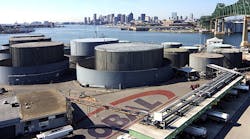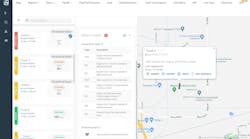MIKE Challman, vice-president of North American Operations for CLX Logistics, said he came to this year’s Intermodal Bulk Liquid Symposium as a quasi-evangelist preaching on the benefits of inbound logistics.
“Logistics is something incredibly neglected in the industry as far as manufacturers having control and taking advantage of the dynamics of their inbound network,” he said during the annual symposium that was held October 17 in Kemah, Texas.
“We’ve done this a lot and seen this where it can work for everybody, where a carrier ends up in a better place because he’s moving more efficiently, the supplier is able to plan more efficiently and can focus on manufacturing their own product and don’t have to worry about transportation, and the shipper can understand what it’s really costing them and start influencing that. It’s hard to get people to bite on it, but I haven’t had a customer yet who got to the top of the hill and said, ‘It’s not worth the climb.’ ”
He said manufacturers of consumer packaged goods are well ahead of chemical manufacturers in gaining control of inbound, in large part because of the simplicity of consumer products.
“Boxes are square, they stack, and you can break them up into parts easily and put them back together,” he said. “That’s not always so in chemicals, and certainly not in bulk chemicals. So the approach is a little different. It’s more about visibility, knowledge, and intelligence.”
The benefits of inbound logistics management:
• Improved shipment visibility.
“When I’ve asked customers, ‘How do you know when your inbound freight is going to be there?’ every one of them has said, ‘The truck arrives or somebody calls and says the truck is about to arrive.’ That’s just the world they live in. They don’t have good visibility to what’s out there. They don’t include that in the calculation of inventory and product readiness and materials they need.”
• Visibility to true costs of transportation.
“Many times it’s embedded in freight or product. Other times it’s listed as a line item on the invoice, but there’s nothing that says that line item correlates to a carrier invoice so I know that’s the true cost. A lot of times it’s a mystery to the shipper. Worse still, sometimes we have customers or manufacturers who say the inbound transportation is free. It is not free. You’re paying for it. It’s just not evident to you.”
• Opportunity to secure better rates and service.
“A lot of times they’re just trusting on a supplier to have a good rate and relationship with the carrier. The suppliers aren’t in the transportation business in most cases. It could be a lot of things that caused that supplier to use that carrier.”
Challman said one reason a lot of manufacturers and shippers have not spent as much time on inbound as outbound is that it’s alot more difficult.
“There’s a lot more that’s not in their control,” he said. “Outbound is a lot easier to see and put limits behind. Not so on the inbound side, where a lot of times they don’t know what suppliers’ plans are for manufacturing and how that’s going to turn into a shipment plan and a product at the dock. They just abdicate that responsibility to the shipper and let them be in control of that, and suppliers like that, to a large degree.”
Other challenges:
• Transportation costs are often embedded in the product cost.
“A lot of times suppliers are making money on it. Even though they might list it as a separate item, it’s actually an allowance or calculation, and they’re making a margin on the freight. That’s good, but it should be known. From the standpoint of the carrier on one end and the shipper who’s receiving on the other end, that’s limiting the ability of other people to make their money. If it’s going to be a money-making endeavor, it’s important to know that.”
• The manufacturer may rely heavily on a particular supplier.
“That’s especially true in chemicals. You’ve got a lot of folks who have to buy from this very small group of suppliers. You lose some leverage. The shipper can’t be as direct about, ‘I want to get control of the freight. I want to be able to pull the trigger.’ That’s OK, too. From our experience, if you have a shipper or manufacturer who has lots of suppliers, there is going to be a small population of them that are untouchable. And there will be a big population that you can influence and impact. Figure out where the price is and figure out where the shortest path to a good result is.”
• Transport mode conversion is not always simple with chemicals.
“But that doesn’t mean there can’t be mode conversion. We have seen a lot of opportunities in the last six to nine months in conversion from truck to intermodal because there are a lot of suppliers that are shipping trucks because that’s what they do and that’s what’s easy. There’s not necessarily a big rush on product and there’s nothing that says it couldn’t have gone intermodal. Obviously every truckload can’t convert to intermodal, but a lot of them can.”
• Vendors may be reticent to share information or surrender control.
“There are operational problems you have to overcome. There’s the mechanics of doing it. But there’s a much bigger cultural thing you have to overcome that says, ‘We’re going to do business differently and have different visibility and expectations of each other. That has to be part of the inbound conversion effort or all the technology and all the process description in the world won’t work and give you the results you want.”
The approach:
• Analyze and understand inbound lanes and freight flows.
“Do we know what they are? I’m always surprised at how many times manufacturers are not clear on where they’re buying from. They think they’re buying from here because that’s where the invoice comes from, but it’s actually shipping from there. It’s time well spent—to start digging into what’s happening at the dock. For the most part, suppliers are very cooperative.”
• Determine whether the inbound freight cost is a line item or embedded.
“We have a carrier group that does benchmarks we can rely on. We can look at the rate and say, ‘Does that look like a good industry rate or is there something funny about it?’ ”
• Establish an inbound freight cost baseline.
“What is the cost of bringing this in?”
• Determine who currently manages inbound rates and relationships.
“This has happened more than once in my experience: A supplier has tremendous rates because of his relationship with a carrier, or the volume he’s doing. In other cases, nobody is controlling the relationship. There’s a lot of spot rate going on, a lot of brokering going on. But it’s important to know who’s doing it.”
• Identify which vendor(s) to convert first, and mode conversion opportunities.
“It may be a vendor who is most cooperative to work with, and there will be some you never want to touch. It doesn’t mean that the program doesn’t work and shouldn’t take place. It just means it doesn’t have to be an all-or-nothing proposition.
• Establish a conversion strategy (timeline, resources).
“You can’t be rushed but also can’t drag it out. We’ve found that from starting the project to doing the first conversion is two to three months, and then we roll it out over time. Big bang is a bad way to do it. Much better to do it vendor by vendor, location by location.”
• Communicate regularly with vendors, carriers, and your organization.
“It’s a cultural change as much as an operational change. People have to start doing things differently, so they have to be communicated with. People are sensitive about what it does to their business. So making sure that things are relatively transparent, particularly where the supplier, carrier, and shipper are involved, is critical because a lot of people are going to doubt this and think there are reasons why it won’t work. So there have to be constant updates and assurance.”
He said the prize is worth it. Inbound transport cost reductions of more than 10% are achievable.
“That’s a big number,” he said. “We just did this not long ago with a customer that had about $10 million of inbound freight we were targeting. You get 10% of that, and that’s $1 million we can hand to the logistics manager and say, ‘Go to your bosses and say we can get a million dollars in savings.’ I have never seen an inbound operation that was unmanaged or decentrally managed that didn’t have a lot of benefit. We’ve seen a lot that were close to 20% if they were poorly managed. There’s a lot of money to be made and a lot of money to be saved. And it doesn’t necessarily have to be at the expense of carriers. I tell my carrier that all time: ‘We’re not trying to take money out of your pocket. We’re trying to take inefficiency out of the supply chain so you still make what you’ve got to make and the shipper still gets a good rate. We’re trying to get rid of waste and excess.’ ”








